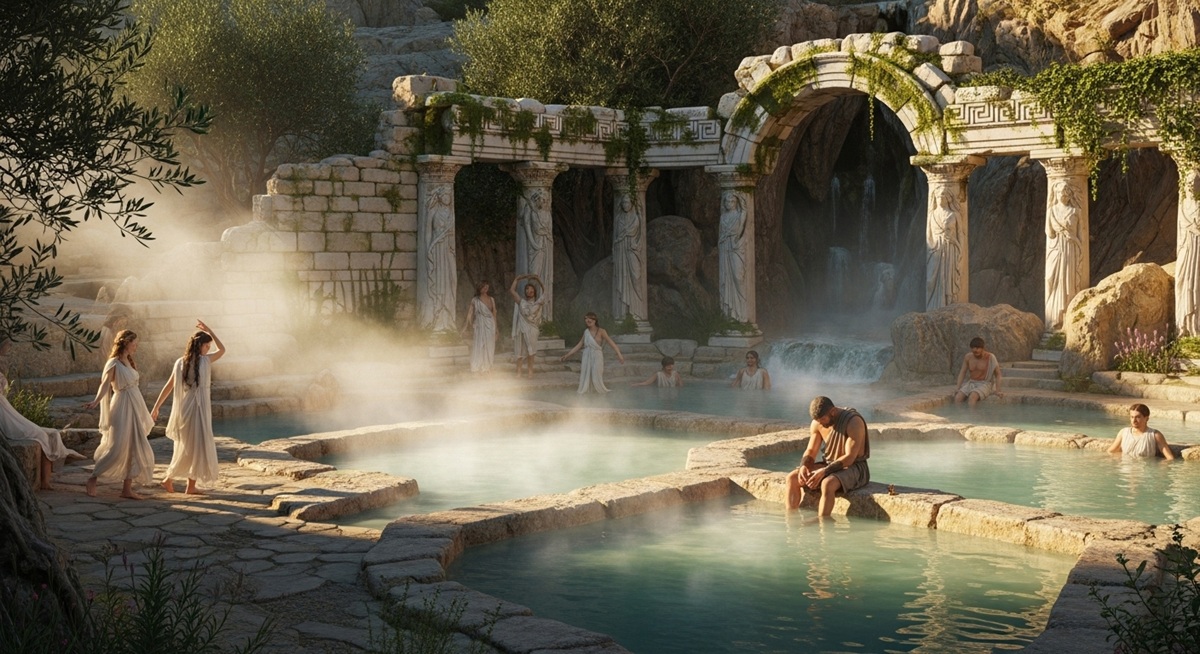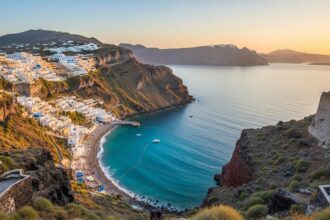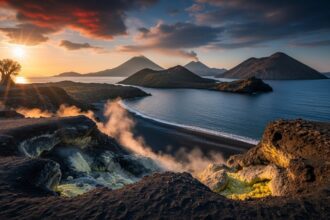Some people chase the sun-kissed beaches of Mykonos or Santorini, dreaming of azure waves and endless ouzo. Others hunt down the creamiest feta in Athens’ bustling markets, pairing it with olives that taste like they’ve been kissed by the gods. But then there are the wanderers—the ones who carry dog-eared copies of Homer in their backpacks and whisper ancient incantations under their breath. These souls come to Greece for the healing waters, the thermal springs that bubble up from the earth’s core like forgotten secrets from the underworld.
We’re not talking about your average spa day with cucumber slices and elevator music. No, these are the Greek thermal springs—mineral-laden, steaming pools steeped in ancient Greek mythology, where nymphs once danced and heroes like Hercules sought solace after battling beasts. Before modern medicine turned wellness into a billion-dollar industry, the ancient Greeks revered these springs as gifts from the gods. Asclepius, the deity of healing, had sanctuaries built near them, and nymphs—those ethereal spirits of nature—were said to guard the waters, infusing them with restorative powers. Hippocrates himself, the father of medicine, prescribed hydrotherapy here, believing the minerals could mend everything from battle scars to broken hearts.
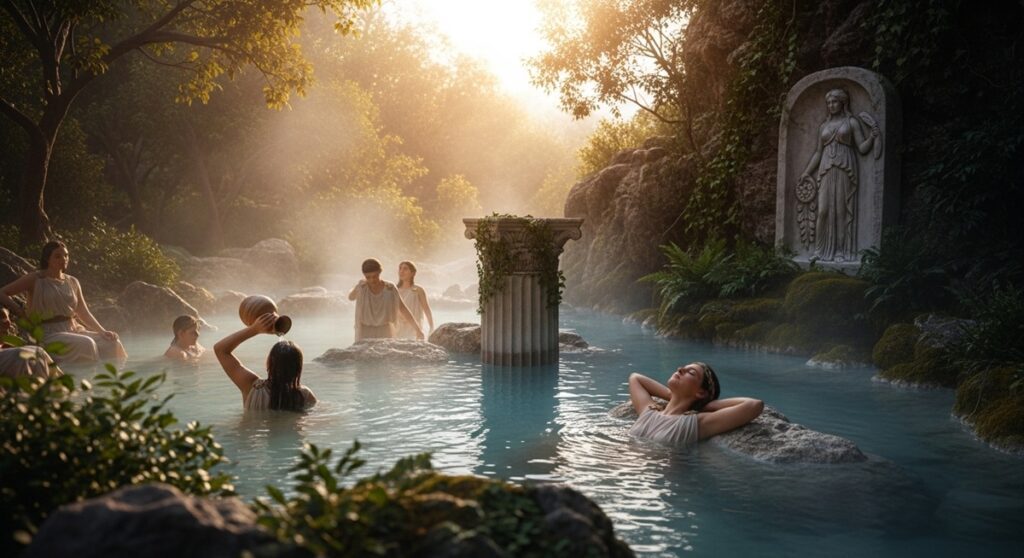
Imagine dipping into waters that have flowed since the time of myths, where the air hums with sulfur and stories. They’re portals to a world where mythical magic meets real-world relief.
Loutraki: Where Artemis’ Whisper Meets Modern Bliss
Nestled just an hour’s drive from Athens, Loutraki feels like a hidden gem that’s been waiting for you since antiquity. This coastal town, once known as Thermai Artemis in ancient times, owes its fame to the thermal springs that have bubbled forth for millennia. The waters here clock in at a soothing 37°C, rich in minerals like sodium and calcium that promise to melt away tension like wax under the Greek sun.
The Mythological Collage of Loutraki’s Waters
In ancient Greek mythology, Loutraki‘s springs were tied to Artemis, the goddess of the hunt and wilderness. Legends whisper that she bathed here to renew her strength after chasing wild boars through the mountains. But the real magic lies in the broader lore of healing waters—guarded by naiads, the freshwater nymphs who ensured the springs’ purity and potency. These spirits, daughters of river gods, were believed to heal ailments through their divine essence, turning a simple soak into a ritual of rebirth. Spartans, those iron-willed warriors, reportedly used these waters for post-battle recovery, echoing the myths where heroes sought similar respite.
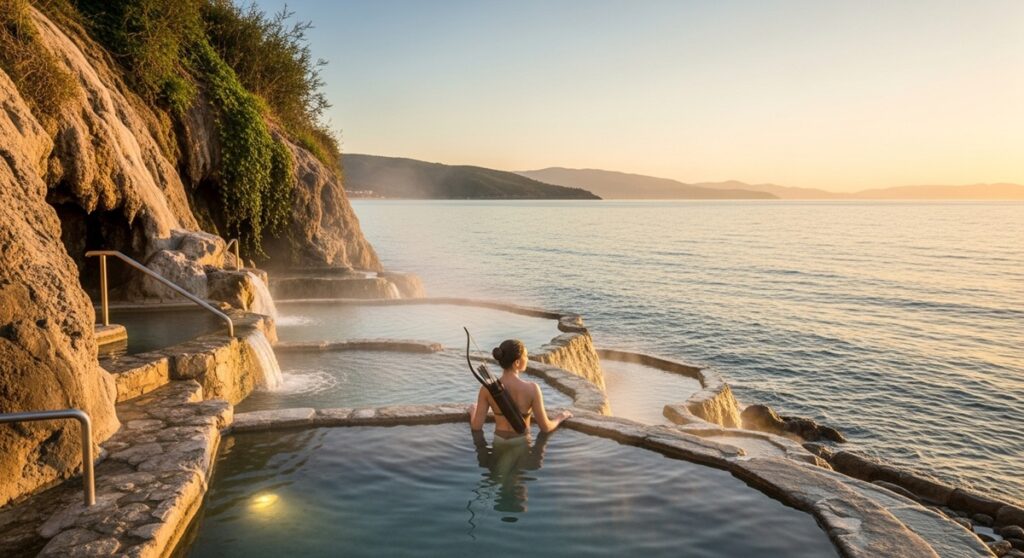
Historically, Loutraki has been a therapeutic hub since Corinthian times, with Romans building elaborate baths that rivaled their imperial spas. Excavations reveal ancient villas and thermal facilities, proving this wasn’t just folklore—these waters were a lifeline for the elite, from philosophers pondering existence to generals nursing wounds.
Healing Benefits and What to Expect
What draws modern travelers? The springs are renowned for easing arthritis, improving circulation, and quieting the mind’s endless chatter—perfect for combating “existential overthinking” in our fast-paced world. At the Loutraki Thermal Spa, you’ll find marble tubs filled with naturally warm water, where you can lounge as steam rises like offerings to the gods. Sessions start at around €20, and the mineral content helps with skin issues too, leaving you glowing like a freshly polished statue.
Travel Tips for Your Loutraki Adventure
Getting here is a breeze: Hop on a bus from Athens or rent a car for scenic views of the Corinth Canal. Stay at beachfront hotels like the Club Hotel Casino Loutraki, where rooms overlook the Gulf of Corinth. Pair your soak with a hike in the nearby Geraneia Mountains, or visit the ancient ruins of Heraion for a full mythological immersion. Don’t miss the local tavernas serving grilled octopus—fuel for your inner explorer. Best time? Spring or fall, when crowds thin and the waters feel even more magical under crisp skies.
Pozar: Nymphs’ Playground in Macedonia’s Wild Heart
Tucked beneath the snowy peaks of Mount Voras in northern Greece, Pozar (also called Loutra Pozar) is where nature stages its own fairy tale. These open-air pools, fed by underground sources at 37°C, cascade into waterfalls amid lush forests, creating a scene straight out of a dream. It’s like bathing in a living painting, with mist curling around ancient trees and the sound of rushing water as your soundtrack.
Myths and Legends Bubbling from the Depths
Pozar‘s lore ties into the grand tapestry of Macedonian mythology. Near the birthplace of Alexander the Great, these springs were said to be tended by nymphs who oversaw natural wonders, ensuring the waters’ healing flow. Tradition holds that Alexander himself sourced timber from these forests for his legendary sarissa spears, perhaps drawing strength from the mineral-rich baths before conquering the world. In broader ancient Greek mythology, such springs were domains of naiads, who could heal skin woes or soothe weary souls with their enchanting presence—think forest spirits inviting you to unwind after a heroic hike.

Though officially recognized in the 1920s, the site’s history stretches back to ancient times, with influences from the Kingdom of Macedonia and even Bulgarian eras, blending cultures in its steamy embrace.
Restorative Powers for Body and Spirit
The waters here are a balm for skin disorders, respiratory issues, and post-adventure aches—ideal for hikers nursing sore knees from Mount Voras trails. Minerals like sulfur and iron work their magic, promoting detoxification and that elusive “good vibes” glow. Entry to the natural pools is cheap (about €3), with options for private baths or hammam experiences.
Planning Your Pozar Pilgrimage
Drive two hours from Thessaloniki, or take a bus to Aridaia and hike the short trail to the springs. Lodging ranges from cozy guesthouses to the Pozar Spa Hotel, complete with indoor pools. Combine with visits to Edessa’s waterfalls or Pella’s archaeological site for a history-myth mashup. Winter visits are enchanting, with snow framing the hot pools like a Studio Ghibli scene— just bring warm layers for the contrast.
Edipsos: Hercules’ Haven on Evia’s Rugged Shores
On the island of Evia, Edipsos boasts over 80 natural thermal springs, some spilling directly into the sea like infinity pools crafted by Poseidon himself. This is where sulfur-scented steam meets crashing waves, creating a sensory symphony that’s been drawing seekers for centuries.
Hercules’ Legendary Soaks and Divine Origins
No spring screams mythical magic like Edipsos. According to legend, Athena, goddess of wisdom, beseeched her brother Hephaestus—the forge god—to strike the earth and create these baths for her favored hero, Hercules. After his grueling Twelve Labors, Hercules bathed here to restore his mighty frame, the waters easing his muscle strains and battle fatigue. The springs were once called “Hercules Thermal,” a nod to this tale, and nymphs were thought to enhance their curative vibes.
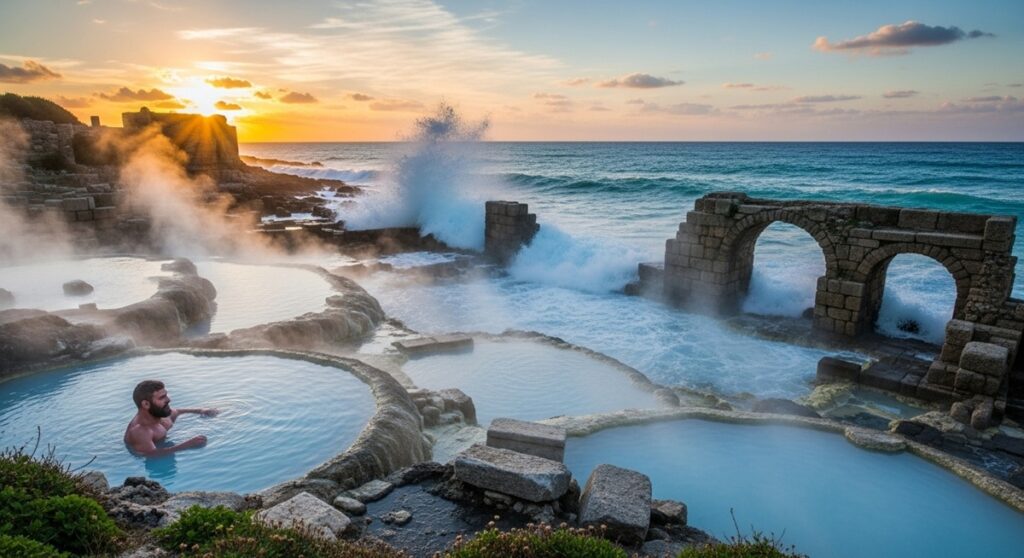
History amplifies the myth: Homer mentions ancient Euboea in the Iliad, and Roman general Sulla was cured of a skin ailment here. Ruins of Roman baths dot the landscape, testifying to its enduring allure as a healing sanctuary.
Therapeutic Wonders for Modern Ailments
Perfect for rheumatism, spinal woes, and low energy, the sulfur-rich waters (up to 80°C in some spots) demand respect—mix with cooler sea water for comfort. They also tackle “myth-induced trauma,” or what we call everyday stress. Public beaches offer free dips, while spas like Thermae Sylla charge €50+ for luxurious treatments.
Evia’s Edipsos: How to Immerse Yourself
Ferry from Athens (two hours) or drive across the bridge to Evia. Stay at historic hotels like the Thermae Sylla Wellness Hotel, with sea views and on-site springs. Explore nearby Lichada’s beaches or hike to monasteries for panoramic vistas. Summer crowds peak, so aim for shoulder seasons; pack reef shoes for rocky entries.
Kyllini: Peloponnese’s Muddy Miracle Amid Pines and Sands
Hidden in the western Peloponnese, among pine-scented forests and golden beaches, Kyllini (or Loutra Kyllinis) feels like Gaia’s personal detox retreat. Roman emperors once soaked away their excesses here, and today, the clay mud treatments turn visitors into rejuvenated versions of themselves.
Sanctuaries of Gods and Ancient Rituals
Kyllini‘s springs pulse with mythological energy. Ancient sanctuaries to Asclepius, the healing god, and Aphrodite, goddess of beauty, stood nearby, where pilgrims sought cures through ritual baths. Nymphs guarded the waters, their presence invoking fertility and renewal. Romans built grand baths, blending Greek lore with imperial engineering, making this a crossroads of cultures.
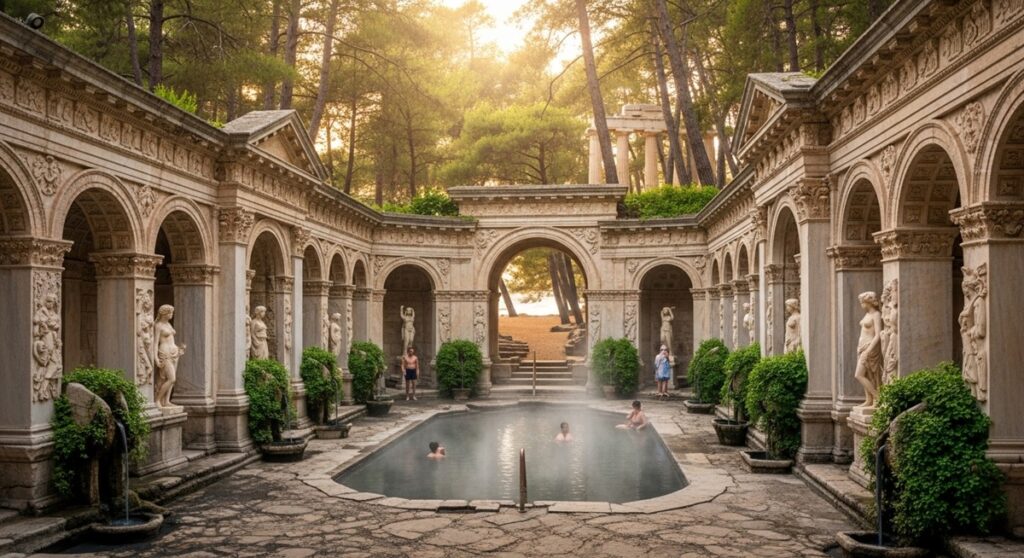
The site’s history dates to Homeric times, with remains of temples underscoring its sacred status.
Healing from Skin to Soul
Ideal for skin disorders, inflammation, and hangover recovery (or cheese-pie overindulgence), the mud packs draw out toxins, leaving skin “baby dolphin soft.” Waters at 25-30°C aid detoxification and relaxation.
Kyllini’s Coastal Charm: Visitor Essentials
Drive three hours from Athens or ferry to nearby ports. The Grecotel Olympia Resort offers spa access and beachfront luxury. Wander Chlemoutsi Castle or lounge on Kyllini Beach post-soak. Spring visits avoid summer heat; try local honey for a sweet mythological touch.
Thermopylae: Spartan Spirit in Steaming Pools
Yes, that Thermopylae—epicenter of the 300 Spartans’ stand against Persia. But beyond the battlefield lore, tucked into rocky hillsides, lie sulfur-rich thermal springs flowing into natural pools, offering a raw, unpolished escape.
Gates to the Underworld and Warrior Legends
Named “hot gates” for its springs, Thermopylae was mythically an entrance to Hades, where steaming vapors evoked the underworld’s breath. Hercules reportedly frequented these waters, aligning with broader healing myths. Spartans, embodying stoic valor, may have soaked here post-training, channeling the nymphs‘ restorative magic amid echoes of Leonidas’ defiance.
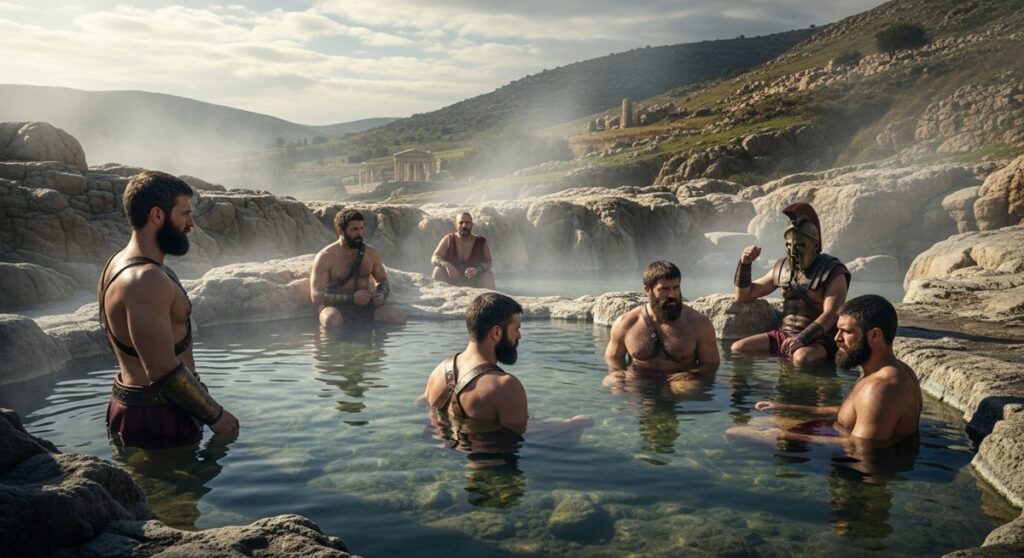
The 480 BC battle immortalized the site, but the springs’ history predates it, tied to ancient wellness practices.
Relief for Warriors of Today
Great for muscle fatigue, old injuries, and “overachiever syndrome,” the simple pools encourage contemplation—no frills, just hot water and history.
Thermopylae Travel: Stand with the Spartans
Three hours north of Athens by car; visit the Leonidas statue en route to the springs. Stay in nearby Lamia for basic comforts. Pair with Delphi’s oracle for mythic depth. Any season works, but fall’s colors enhance the drama.
Why Greece Masters the Art of Healing
In Greece, healing isn’t a fleeting trend—it’s woven into the land’s rhythm, a return to elemental truths. The thermal springs blend ancient Greek mythology with tangible benefits, where nymphs and minerals conspire to hold you. No need for fancy packages; just show up, barefoot, with a Sappho poem in hand.
If the sea calls to your tiredness, and the springs to your breaks, heed Greece’s whisper. Beneath myths and marble lies a truth: the healing waters know how to cradle your weary self.







